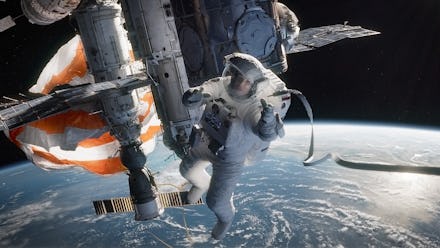While Gravity Made $700M and Won 7 Oscars, Congress Slashed NASA’s Budget By $1B

Last night while Gravity was dominating the Oscars by winning seven awards, NASA was dominating the Internet. Showing once again its brilliance in public communication and nose for a viral moment, under the hashtag #RealGravity, the agency tweeted out stunning photos of real life in space.
Although Gravity is jaw-dropping and has some of the best special effects ever seen in a film, NASA's images remind us that nothing compares to the amazing real work the space program does. What's incredible is that this boundary-breaking research is being done on an increasingly shrinking budget. While modern blockbusters such as Gravity spend $100 million or more on state-of-the-art special effects, NASA has sustained cuts year after year, resulting in several cancelled projects.
With this in mind, we thought that it might be fun to compare the achievements and costs of Gravity with NASA's space exploration program.
1. Overall Success
Gravity: Crushed the Oscars in 2014, winning seven awards.
NASA: Last year, Curiosity Rover discovered water on Mars.
Advantage: NASA. Duh. Nothing beats amazing new scientific knowledge, especially when it points to the possibility of extraterrestrial life. Nothing.
2. Cost
Gravity: Cost $100 million to produce.
NASA: Per year, Mars Curiosity Rover costs $50 million to run. Saturn Cassini spacecraft costs $60 million.
Advantage: NASA. That's right, modern day blockbusters cost more to produce than groundbreaking space missions cost to maintain. No doubts here as to what's the more exciting use of money.
3. Special Effects
Gravity: Among the best visual effects (VFX) ever seen in a motion picture, with an Oscar to prove it. The secret? A 10-by-10 foot "light box" fitted with 4,096 LED light bulbs to simulate the extreme light in outer space. Roughly 60% of the scenes were filmed using the light box.
NASA: Curiosity Rover has 10 different scientific instruments that can, among other things, take panaoramics of the Martian landscape, detect radiation, look for moisture and analyze soil samples.
Advantage: NASA. One of the Curiosity Rover's instruments is an on-board laser that has fired over 1,000 shots on Mars. How cool is that? Also, Hollywood doesn't appear to be treating its VFX workforce very well.
4. Revenue
Gravity: The movie grossed over $700 Million in theatres worldwide. In total, the global entertainment industry is worth close to $2 trillion.
NASA: Last year, NASA suffered budget cuts equivalent to $1 billion.
Advantage: Gravity. While other industries receive bailouts and subsidies, valuable scientific agencies that drive human advancement have consistently been among the first to feel the pain from austerity measures.
5. Government Support
Gravity: Each year, the film and television industry receives around $1.5 billion in subsidies to incentivize the production of new movies.
NASA: Last year NASA was shutdown by Congress for 16 days.
6. Universal Appeal
Gravity: Gravity was a smash hit all around the world, reaching no. 1 in box offices in the U.S., China, Russia, France, U.K., Korea, Mexico and many other countries.
NASA: Has been to all eight planets in the solar system. It's furthest spacecraft, Voyager 1, has made it outside the Solar System at a distance of 19,038,000,000 km from Earth.
Advantage: NASA. Its spacecrafts are officially interstellar.
7. Team Size
Gravity: According to IMDb, around 1,000 people were involved in creating the movie.
NASA: Around 700 people are currently employed to operate Mars Curiosity.
Advantage: NASA. Amazingly it takes fewer people to explore an entire other planet than it does to make a fictional story about space exploration. NASA once again shows that it is able to do a lot with very little.
8. Salary
Gravity: Sandra Bullock has made an astronomical estimated $70 million from the movie.
NASA: Astronauts start on a salary of $60,000, which can rise up to $130,000.
Advantage: Gravity. No doubt what's the more lucrative career here. Also, Sandra Bullock gets to use a stunt double. No such luxury for those out doing regular repairs on Hubble and the real International Space Station.
9. Artistry
Gravity: Won Oscar for best cinematography.
NASA: Produced the most important image of all time.
Advantage: NASA. Gravity does a fantastic job of conveying the myriad of dangers involved with space exploration, but nothing is a greater reminder of our fragile existence than the iconic "Earthrise," taken on Christmas Eve in 1968 by Apollo 8.
Verdict: Gravity may have won an astonishing 7 Oscars and swept box offices around the globe, but from here to Neptune it's clear — NASA conquers all. This isn't at all a slight on Gravity. It's a gorgeously gripping and well executed piece of fiction that got audiences everywhere engrossed with space exploration. NASA astronauts themselves aboard the International Space Station were among the first to congratulate the Gravity team on their success.
Despite the dazzling achievements of programs like NASA, relative to our support for the entertainment industry, we continue to undervalue our scientific community. It's fantastic that movies based on science like Gravity can garner wide acclaim, but somewhat ironic that we let funding for real science itself slowly decay at the same time.
Of course, there's no such thing as billion dollar-generating box offices for science. Unlike the movies, science isn't there to be consumed for entertainment. Science is there to inspire. But for it to continue inspiring us, we need to support it politically and in our budgets as fast as we rush to the theater every Friday night.